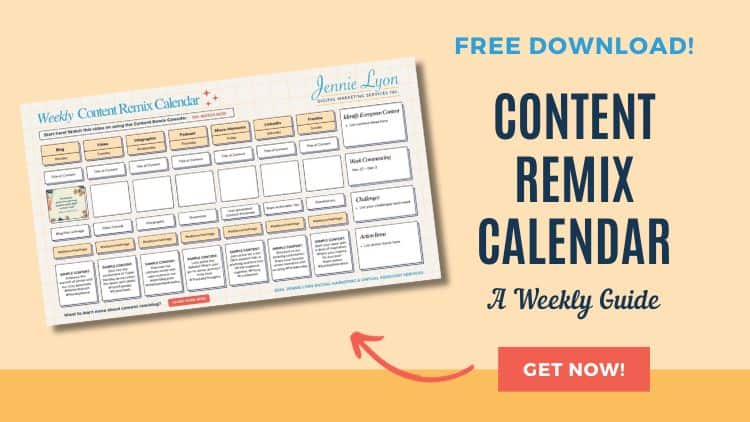Fantastic Ways To Repurpose Your Content + Free Template and Video
Content remixing. It’s not just a trendy term; it’s your ticket to boosted reach and SEO success.
Imagine crafting a killer blog post and then picture that content reaching a wider audience, not just once but multiple times. That’s the magic of content remixing. It’s about making your existing content work smarter, not harder.
Remixing is more than recycling; it’s unleashing your content’s potential across various platforms and formats. Nonetheless, more visibility means more eyes on your brand – a win in digital marketing.
Why settle for a one-time audience when you can extend your content’s lifespan? Our goal is crystal clear: take that ONE amazing piece of content and stretch it further than you thought possible. Obviously, we’re talking about making it resonate for the long haul.
Content Overview
- Understanding Content Remixing
- Identifying Evergreen Content
- Content Remix Strategies
- Infographics and Visual Storytelling
- Podcasting: Turning Video Insights into Conversations
- Micro-Moments: Reel in the Engagement
- LinkedIn Insight: Crafting Article Magic
- Checklist Creation: Transforming Steps into Action
- Cheat Sheet: Condensing Wisdom into a Handy Guide
- Key Metrics for Tracking Your Content’s Impact
Understanding Content Remixing
So, let’s get down to the nitty-gritty. What is it, why does it matter, and how can it make your life easier?
Overall, content remixing is like giving your content a makeover – a fresh perspective. Take your existing gems, be it a killer blog post, engaging video, or podcast episode, and transform them into various formats.
Why does this matter? Variety is the spice of life. Different people prefer different formats. By embracing content remixing, you’re casting a wider net.
Finally, let’s talk about the benefits – the sweet perks.
Increased Visibility
Imagine your content appearing not just on your blog but also as engaging videos on YouTube, eye-catching infographics on social media, and informative snippets on podcasts. So, more platforms mean more eyes on your content.
Resource Efficiency
Creating content from scratch is time-consuming. Hence, with content remixing, you’re maximizing what you already have. So, it’s like having a wardrobe full of versatile pieces.
SEO Optimization
Search engines love fresh content. When you remix, you’re breathing new life into your existing material. Google sees your content as current and relevant, giving you a boost in the search rankings.
Furthermore, content remixing isn’t just a buzzword; it’s a strategy that amplifies your reach, saves you time, and plays nicely with search engines.
#1: Identifying Evergreen Content
Firstly, let’s talk about creating content that stands the test of time – the evergreen stuff. We’ll break down how to spot it and share some shining examples.
Evergreen content is like that timeless classic song you never get tired of hearing. It remains relevant, useful, and valuable regardless of trends. How do you spot it? Keep your radar tuned to two key things: longevity and user intent.
Longevity: Evergreen content isn’t a one-hit wonder. So, it stays relevant for months, even years – think of how-to guides, in-depth tutorials, or fundamental principles in your niche.
User Intent: Evergreen content addresses ongoing needs. So, it’s user-centric, focusing on what your audience wants. When you align your content with user intent, you’re creating pieces that stay evergreen.
Examples of Successful Evergreen Pieces
Let’s take a look at some real-world examples:
How-to Guides
Whether it’s “How to Start a Blog” or “How to Bake the Perfect Chocolate Chip Cookies,” these guides never go out of style.
Educational Resources
Content that teaches a skill or provides valuable insights – “The Ultimate Guide to SEO” or “Understanding the Basics of Investing.”
FAQs and Troubleshooting
Address common questions and problems in your field. “Troubleshooting Your Smartphone” or “FAQs about Sustainable Living” – these pieces are always relevant because people seek solutions.
Finally, armed with this knowledge, let’s infuse that evergreen magic into our remix strategies.

Free Resource – Ready to give content remixing a try? Grab our free weekly content remix calendar & video! This free weekly guide will help you turn your ONE piece of weekly content, into MANY pieces that you can use for all of your other types of content!
#2: Content Remix Strategies
Begin with a robust script. Your blog post lays the foundation, but for a video, a well-thought-out script is the key. Outline key points, maintain a conversational tone, and infuse it with your unique personality.
Elevate your video’s visual appeal with compelling visuals. Incorporate images, graphics, and perhaps a touch of animation to keep your audience visually engaged. Lastly, break down complex ideas using visuals.
No need for a Hollywood studio – user-friendly tools like Lumen5, InVideo, or Canva can seamlessly turn your blog into a visually stunning video.
Leveraging Video Platforms for Extended Reach
1. Dive into the world of YouTube
Create a dedicated channel, upload your videos, and optimize the video descriptions with relevant keywords. Also, remember, YouTube isn’t just a video platform; it’s the second-largest search engine globally, making it a powerhouse for discoverability.
2. Transcribe for SEO Goodness
While search engines can’t watch videos, they can read text. Transcribing your video content provides search engines with valuable information, significantly enhancing your chances of being discovered through organic search.
3. Promote on Social Platforms
So, don’t limit your video to YouTube. Share it across various social media platforms. Each platform boasts its unique audience, and by diversifying your presence, you increase the likelihood of reaching and engaging with your target audience.
#3: Infographics and Visual Storytelling
Blog posts with key points, statistical data from videos, and summarized insights from podcasts can all be excellent content types to remix into infographics.
Infographics work well when you want to condense information into visually appealing and easily digestible formats.
First, identify the main points of your video or blog post, but consider using icons or illustrations that represent each point.
Choose a color scheme that complements your brand or video content.
Use clear fonts for readability, ensuring the text is concise.
Lastly, arrange the elements in a visually appealing layout. Once designed, share the infographic on your website, social media platforms, and Pinterest to enhance visibility and engagement.
Sharing Infographics on Various Platforms
1. Social Media Platforms
Share your infographics across diverse social media platforms. Each platform has its strengths – Pinterest for discovery, Twitter for quick shares, and LinkedIn for professional audiences. Tailor your approach to each platform.
2. Embedding in Blog Posts
Integrate infographics into your blog posts. They serve as visual aids, making your content more engaging and shareable. Don’t forget to include a shareable link for your readers.
3. Email Newsletters
Feature infographics in your email newsletters. Visual content tends to capture attention more effectively than plain text. Use them to highlight key points, statistics, or summaries.
4. Building Backlinks
Leverage infographics for backlink building. Meanwhile, reach out to websites and blogs in your niche, offering your infographic as a valuable resource. When others link to your infographic, it not only boosts your visibility but also enhances your website’s authority.
#4: Podcasting: Turning Video Insights into Conversations
Instead of a one-way video lecture, turn your video or blog posts into dynamic conversations on your podcast. Extract key points and frame them as engaging topics. Furthermore, invite guests to share diverse perspectives, encouraging a dialogue that resonates with your audience.
1. Structure your Episode Approach
Create a clear structure for your episodes. Whether it’s an interview style, storytelling, or a solo exploration, a well-defined format helps your listeners follow along and enhances their overall experience.
2. Share Actionable Takeaways
Wrap up each episode with actionable takeaways. Your audience should leave with valuable insights or practical steps they can implement. Providing actionable advice not only adds value but also encourages repeat listenership.
Tips for Effective Podcast Distribution and Promotion
1. Strategic Distribution Platforms
Choose your podcast distribution platforms wisely. While major platforms like Apple Podcasts and Spotify are crucial, explore niche platforms that cater to your specific audience. Diversify to reach a broader spectrum of listeners.
2. Cross-Channel Promotion
Spread the word about your podcast across various channels. Utilize social media, email newsletters, and even your blog to create anticipation. Teasers, behind-the-scenes snippets, and encouraging audience interaction can boost your podcast’s visibility.
3. SEO Optimization Strategies
Optimize your podcast for search engines. Craft compelling episode titles and descriptions with relevant keywords. Transcribe your episodes to provide search engines with more content to index, increasing the discoverability of your podcast.
#5: Micro-Moments: Reel in the Engagement
Condensing your YouTube video into a captivating 15-second Instagram Reel is an art that can significantly boost engagement. Packed with music, text, and effects – a viral teaser encouraging viewers to watch the full video.
Here’s a detailed breakdown of how to reel in your audience with these micro-moments:
1. Strategic Selection
Handpick the most attention-grabbing snippets from your full video. So, choose moments that encapsulate the essence of your content, creating curiosity and prompting viewers to watch more.
2. Visual Symphony
Use the visual appeal of Instagram Reels to its fullest. Incorporate dynamic shots, vibrant colors, and quick transitions. Enhance the visual experience with overlays, text, and effects that align with your brand identity.
3. Soundtrack Impact
Music can set the tone for your Reel. Select a catchy, relevant soundtrack that complements your content. The right music not only adds an emotional layer but can also make your Reel more shareable.
4. Text Teasers
Make use of concise and intriguing text overlays. Craft compelling captions or pose questions that leave viewers curious. Use text strategically to convey key messages or highlight the benefits of watching the full video.
5. Engagement Trigger
Insert a call-to-action within the Reel. Encourage viewers to swipe up, follow your account, or visit your profile for more. Creating a sense of urgency or exclusivity can drive immediate engagement.
6. Timing Matters
Instagram Reels thrive on brevity, so timing is crucial. Experiment with the pacing of your visuals to keep the audience engaged throughout the 15 seconds; nonetheless, a well-timed Reel leaves a lasting impression.
7. Tease, Don’t Spoil
Craft your Reel as a teaser, not a spoiler. So, provide a taste of the value your full video offers without giving away all the details. Basically, the goal is to leave viewers intrigued and eager to watch the complete content.
#6: LinkedIn Insight: Crafting Article Magic
Adapt your blog post for LinkedIn, modifying the title, introduction, and conclusion. But be sure to leverage relevant hashtags for increased visibility.
1. Title Refinement
Transform your blog’s title into a captivating headline tailored for LinkedIn’s professional audience. At this time, consider adding keywords relevant to the platform to enhance discoverability.
2. Introduction Optimization
Begin your LinkedIn article with a concise yet impactful introduction. Address the professional context, emphasizing the practical value your content brings to LinkedIn users. Establish a connection between your insights and the LinkedIn community.
3. Hashtag Integration
Harness the power of hashtags to increase the visibility of your LinkedIn article. Basically, identify and incorporate industry-specific and trending hashtags to reach a broader audience interested in the discussed topics.
4. Body Enrichment
Elaborate on key points from your blog, catering to the professional interests of the LinkedIn audience. Provide actionable insights backed by relevant examples or case studies, fostering engagement and discussions within the platform’s professional community.
5. Visual Appeal
Enhance your LinkedIn article with visually appealing elements such as infographics or relevant images. LinkedIn supports multimedia, making it an effective way to capture attention and convey information in a concise yet visually engaging manner.
6. Thought Leadership Tone
Infuse your article with a thought leadership tone, positioning yourself as an authority in the field. Share personal experiences, industry trends, or forward-thinking perspectives to resonate with LinkedIn’s professional audience.
7. Call-to-Action for Networking
Lastly, conclude your LinkedIn article with a compelling call to action. It also encourages readers to share their thoughts, connect with you, or join relevant LinkedIn groups, fostering networking opportunities within the professional community.

Free Resource – So many social media networks are out there, each serving a different purpose. While Facebook connects you to all of your friends, Twitter allows you to share your thoughts in quick 280-character posts. Learning how to utilize the strengths of each social media network to get the word out about your business is the secret of online digital marketing. In this workbook, I will teach you how to get the most out of each social media network.
#7: Checklist Creation: Transforming Steps into Action
Take your video’s steps and convert them into a practical and actionable checklist, offering it as a valuable free download across multiple platforms to encourage engagement.
1. Title Crafting
Develop an attention-grabbing title for your checklist that highlights its utility and relevance. For example, “Video Success Blueprint: 5 Essential Steps Checklist.”
2. Step Breakdown
Transform each video step into a clear and concise checklist item. Use bullet points for easy readability, ensuring that each step is actionable and easily implementable.
3. Visual Enhancement
Incorporate visually appealing elements into the checklist design. Use icons or relevant images for each step to enhance comprehension and make the checklist visually engaging.
4. Platform Diversity
Make the checklist accessible across various platforms. Consider using your website, social media channels, and relevant forums to share the downloadable checklist. Tailor your promotion strategy to each platform’s audience.
5. Call-to-Action Inclusion
Integrate a compelling call-to-action within the checklist, encouraging users to share it with their networks. This not only expands your reach but also facilitates user engagement.
6. Value Proposition Emphasis
Highlight the value of the checklist in your promotional messages. Communicate how following these steps can lead to tangible outcomes, creating a sense of urgency and desirability for the download.
7. Email Newsletter Integration
Leverage your email newsletter to promote the checklist. Send out dedicated emails to your subscribers, emphasizing the benefits of the checklist and providing a direct link for easy access.
8. Social Media Teasers
Tease the checklist on social media platforms with engaging snippets or visuals from the checklist. Use persuasive captions to create anticipation and drive traffic toward the download link.
#8: Cheat Sheet: Condensing Wisdom into a Handy Guide
You can create a cheat sheet with essential tips from your video. Offer it as a free download, enhancing accessibility and value.
Step 1: Spot Your Gem
Take a stroll down memory lane through your content archives. Identify those golden nuggets – you know, the blog posts that got high-fives, the videos that had viewers hooked, or the podcasts that sparked a fan club.
Step 2: Extract the Good Stuff
Now, let’s get surgical. Extract the juicy bits – the tips, the “Aha!” moments, and any visuals that can survive the snip. Basically, think of it as crafting the ultimate highlight reel.
Step 3: Arrange the Party
Time to throw your extracted gems into a party bus. Organize them logically, creating a journey that makes sense for your audience. We’re aiming for a smooth flow, like storytelling around a campfire.
Step 4: Pump it Up with Visuals
No party is complete without decorations! Spruce up your guide with visuals – throw some images, charts, or quirky infographics. It’s like turning your content into a visually stunning fireworks display.
Step 5: Design the Cheat Sheet
Head over to your creative hub and design your cheat sheet or guide. Make it look snazzy and on-brand. Remember, we want our audience to think, “Wow, this is cool, and I need it now!”
Step 6: Spice it Up with Extras
Why stop at cool? Add some spice! Toss in bonus tips, links to more awesomeness, or exclusive content. It’s like slipping in a surprise gift – who doesn’t love a little extra?
Step 7: Ready, Set, Download!
Optimize your guide for download – keep it snappy without losing quality. Then, hit them with a clear call to action, inviting your audience to snag the valuable content.
#9: Key Metrics for Tracking Your Content’s Impact
Engagement Metrics
Keep a keen eye on engagement metrics. Track likes, shares, comments, and click-through rates. These metrics provide insights into how well your content resonates with your audience.
Traffic and Conversions
Monitor website traffic generated from your remixed content. Analyze conversion rates to understand how effectively your content is turning visitors into customers or leads.
SEO Analytics
Dive into SEO analytics. Assess your search engine rankings, organic traffic growth, and keyword performance. These insights help you gauge the impact of your content on search engine visibility.
So, what next?
Remember, content remixing is about creativity, not constraints. Implementing might feel like a daunting task, but remember, it’s okay to start small. Pick one strategy, experiment, and gradually expand. The key is consistent experimentation and learning.
Action Plan
- Take a stroll down your content memory lane. Identify those high-fiving blog posts, captivating videos, or podcast episodes that created a fan club.
- Pick one content piece and identify three key takeaways.
- Organize them logically, creating a journey that makes sense for your audience. Then, sketch out a rough outline for a remix, integrating your three key takeaways.
- Explore any of the above strategies to repurpose your content.
- Outline a rough plan for remixing your chosen content. What format will you transform it into? How will you structure it to engage your audience?
- Sketch a simple outline for your remix, mapping out the journey you want your audience to experience.
- Create and share it everywhere!
- Identify three key metrics you’ll track for your remixed content – engagement metrics, traffic and conversions, and SEO analytics.
- Share your progress, questions, or insights on content remixing in the comments, or reach out for a conversation. Let’s keep the creativity flowing!
Links for this episode:
- Content Remix Template + Video
- 3-Month Content Calendar
- Making the Most of Social Media
- Schedule a Consultation
- Free Resources
Rate, Review, and Subscribe to Apple Podcasts
If you like what you hear on the podcast, please consider rating and reviewing my show! Woo Hoo! Click here, scroll to the bottom, tap to rate with five stars, and select “Write a Review.” I would love to hear what episodes you enjoy the most! If you still need to do so, please subscribe to the podcast. I’ll be adding new content weekly. If you’re not subscribed, you’ll likely miss out. Subscribe now!
























